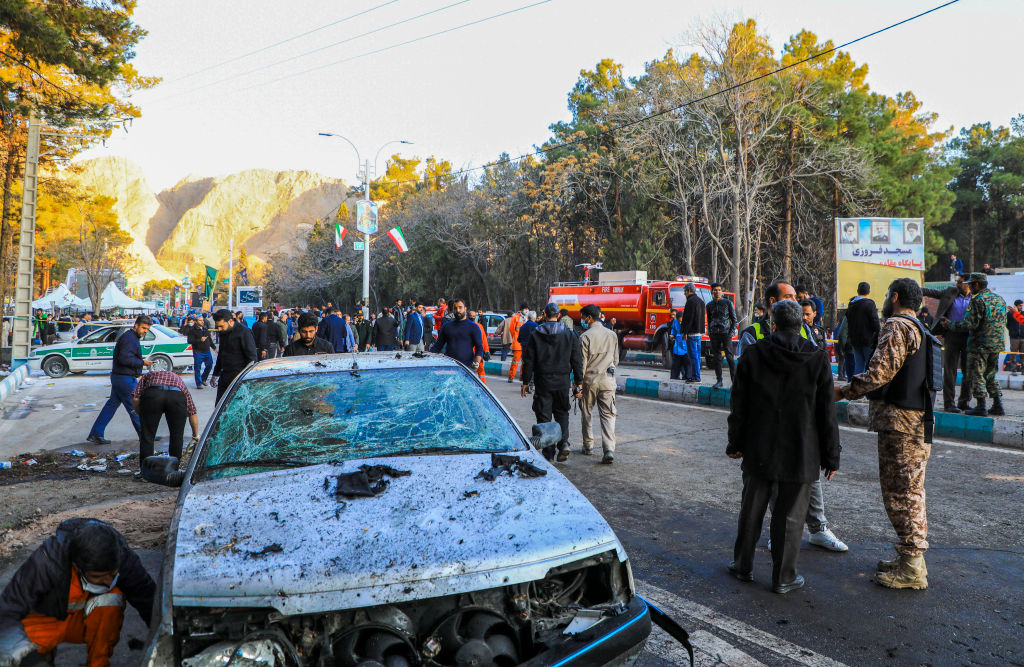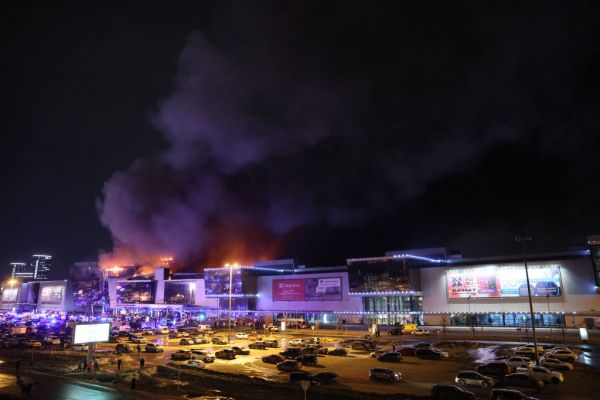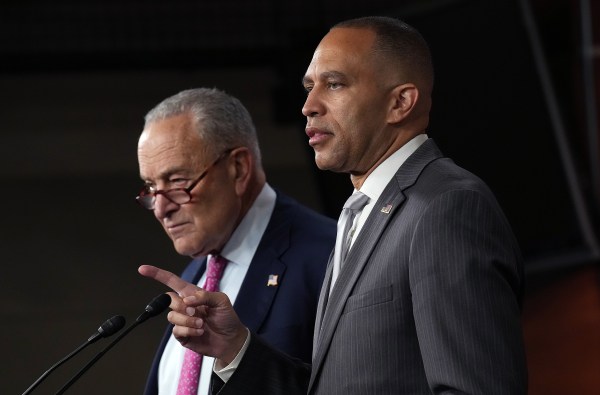Federal agents arrested eight men with suspected ties to ISIS last weekend in Los Angeles, New York, and Philadelphia. There is still much we don’t know about the counterterrorism operation, and it’s possible that information in the first news reports isn’t entirely accurate. But it is also possible that the arrests are highly significant—an indication that the terrorist threat to Americans at home is growing once again, as FBI Director Christopher Wray warned in recent congressional testimony.
According to CBS News, the eight men are natives of the Central Asian country of Tajikistan who entered the U.S. through the southern border sometime since the beginning of 2023. They were allowed to stay in the country after passing initial background checks. Subsequent intelligence revealed they may have connections to ISIS-K (or ISIS-Khorasan), a branch of ISIS’s international network based in Afghanistan that orchestrated deadly mass casualty attacks in Iran and Russia earlier this year. The FBI reportedly wiretapped the men and discovered that at least one of them was discussing bombs. The FBI and U.S. Immigration and Customs Enforcement then coordinated the arrests, and the men are being held on immigration charges as the investigation continues.
The arrests are potentially significant for several reasons. First, ISIS and ISIS-K have repeatedly relied on jihadists from Central Asian countries, especially Tajikistan, to carry out international terrorist operations. Since the beginning of the year, Tajik ISIS terrorists have killed more than 200 people in Iran and Russia.
Second, the U.S. withdrawal from Afghanistan left the Taliban (al-Qaeda’s most important ally) in control of a country teeming with transnational threats. Even though ISIS-K and the Taliban are enemies, the Taliban has been unable or unwilling to cut off ISIS-K’s international tentacles.
Third, the arrests could exacerbate the political tensions over America’s border. At least one of the arrested men reportedly used the Biden administration’s Customs and Border Patrol (CBP) One app to gain entry to the U.S. The CBP One app is intended to allow asylum-seeking migrants to set up appointments for vetting and potential entry into the country. But, if accurate, then the reporting on use of the One app is another indication that suspected terrorists are trying to exploit this system for their own nefarious purposes.
Fourth, U.S. officials have long argued that the main terrorist threat to Americans inside the U.S. comes from lone individuals—extremists with no formal allegiances or ties to organizations based overseas. But if the Tajiks arrested over the weekend were indeed colluding on behalf of ISIS, the threat is evolving once again—to include organized cells that could be far more lethal than individual actors.
Even if there is less to the reporting on these detentions than it first appears, the threat posed by ISIS’s Central Asian contingents is clearly growing.
Tajiks play a significant role in ISIS’s international plotting.
Tajik jihadists have long played a role in ISIS’s international operations. In July 2018, for instance, five young ISIS recruits drove their vehicle into foreign cyclists touring Tajikistan then jumped out of the car and stabbed the cyclists. They killed four people, including two Americans. At the time, combining vehicular assaults with stabbing attacks was a common ISIS technique, employed by ISIS loyalists everywhere from Ohio to London. ISIS promoted the attack in Tajikistan by releasing a video of the five ISIS youths swearing their allegiance to the so-called caliphate’s then-ruler, Abu Bakr al-Baghdadi.
The attack in Tajikistan was an indication of ISIS’s growing ability to attract recruits from there. In July 2019, a United Nations expert monitoring team reported that a prominent Tajik jihadist, Sayvaly Shafiev (also known as “Mauaviya”), served on the shura (leadership) council for ISIS-K. The U.N. team explained that Shafiev led a “contingent of approximately 200 fighters” from Central Asia in eastern Afghanistan, where he was recruiting more “Tajik fighters” and raising “funds using online propaganda in the Tajik language.”
Even as ISIS was recruiting Tajiks inside Afghanistan, it was seeking ways to deploy them abroad.
In April 2020, German authorities arrested four Tajik members of ISIS. The men were allegedly plotting attacks against American servicemembers and the U.S. Air Force. The Germans said the Tajiks were acquiring weapons, including bomb components, at the time of their arrest. Importantly, the Germans also claimed that the cell was receiving direction from ISIS leaders in Afghanistan and Syria—underscoring the global connectivity and reach of ISIS’s network.
On January 3 of this year, an ISIS-K cell carried out near-simultaneous suicide bombings in Kerman, Iran, that killed about 100 people. At least one of the suicide bombers was a Tajik national. The terrorists struck during a memorial service for Qassem Soleimani, the Islamic Revolutionary Guards commander (IRGC) who was killed in a U.S. drone strike in Iraq in 2020 and who had overseen countless terrorist operations of his own during his decades serving the Iranian regime. The Iranian government tried to blame America and Israel for the bombings, even though the U.S. government warned the Iranians beforehand that ISIS-K was planning an attack.
The ISIS-K bombings in Kerman were not the first time ISIS has struck inside Iran. The Iranian regime has long maintained cozy relations with the Taliban, and has also harbored senior al-Qaeda leaders for more than two decades. However, ISIS has sought to distinguish itself from its Sunni jihadist rivals in both of those groups by killing Shiite civilians inside Iran and elsewhere around the globe. Since 2011-12, the Iranian regime has also deployed paramilitary forces and militias to Syria, where they have often clashed with ISIS’s men while seeking to buttress Bashar al-Assad’s regime. This is another reason ISIS seeks to target Iranians inside their own country.
Elsewhere, on January 28, two masked ISIS gunmen opened fire at the Santa Maria Roman Catholic Church in Istanbul, killing one person and wounding another. Turkish authorities identified one of the gunmen as a Tajik and the other as a Russian.
Then, on March 22, a cell of four Tajik ISIS gunmen stormed the Crocus City Hall near Moscow, killing more than 140 people and wounding hundreds more. In the aftermath of the attack, the Russian government reportedly arrested 11 to 12 Tajiks and one Russian citizen, accusing them of acting as a support network for the terrorists. As was the case before the attack in Iran, the U.S. government reportedly warned Russian officials that ISIS-K was planning a terrorist attack inside Russia, and even identified the Crocus City Hall as a potential target. ISIS has been at war with al-Assad’s regime in Syria for more than a decade. And throughout much of that period, Vladimir Putin has provided vital military and other assistance. By terrorizing Russian civilians inside their home country, ISIS and ISIS-K likely sought to punish the Kremlin. The Russian government is also allied with the Taliban, which ISIS-K opposes, providing another pretext for the group to seek targets inside and near Moscow.
A growing threat inside the U.S.
The ISIS attack in Moscow prompted renewed fears of a large-scale attack inside the U.S. Testifying before Congress in April, FBI Director Christopher Wray warned there was an “increasingly concerning … potential for a coordinated attack here in the homeland, akin to the ISIS-K attack we saw at the Russia Concert Hall a couple weeks ago.”
Wray’s use of the phrase “coordinated attack” is noteworthy. U.S. officials have warned for years that the principal threat to Americans here at home comes from “lone” extremists or terrorists who could strike without any real operational assistance from their ideological compatriots abroad. Now, ISIS’s growing transnational capabilities have American officials concerned about the possibility of a bigger, coordinated attack orchestrated from abroad once again.
It’s not yet clear how the arrests this past weekend fit into this threat matrix. But as Wray’s testimony suggests, it is clear the jihadists’ threat to the homeland has not been extinguished.









Please note that we at The Dispatch hold ourselves, our work, and our commenters to a higher standard than other places on the internet. We welcome comments that foster genuine debate or discussion—including comments critical of us or our work—but responses that include ad hominem attacks on fellow Dispatch members or are intended to stoke fear and anger may be moderated.
With your membership, you only have the ability to comment on The Morning Dispatch articles. Consider upgrading to join the conversation everywhere.